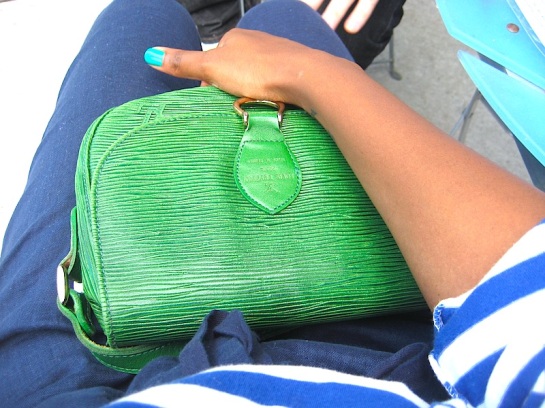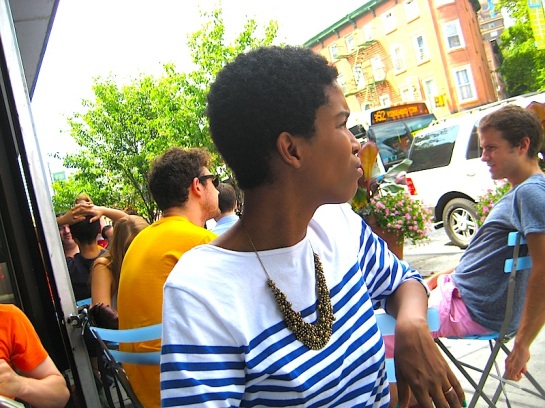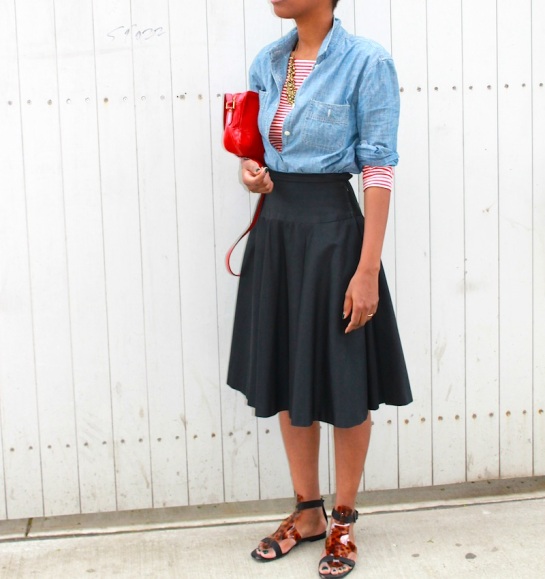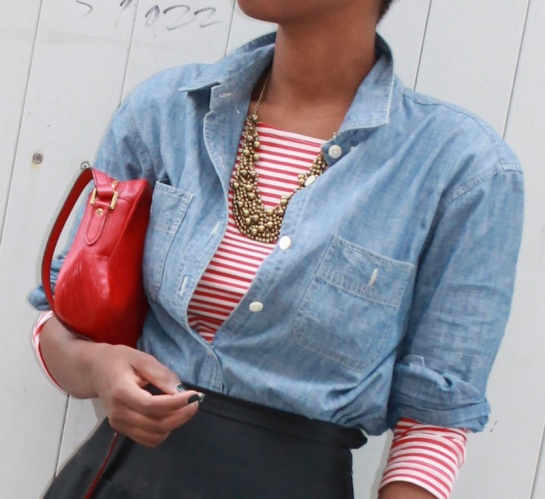Tag Archives: Louis Vuitton
Matter of Keeping It Real
via Harper’s Bazaar/Associated Press
Several winters ago, on one of the first bitterly cold evenings of the season, I had just left a Kehinde Wiley art opening in SoHo with my husband and a good friend of ours. We were starving and needed to be fed quickly. After some deliberation, we decided to go to an eatery owned by a friend’s father in Chinatown, but first a trip to the ATM. We headed southeast away from Greene St. and towards Canal. It was only around 9:00, but the wet streets were virtually deserted.
As we came upon the Bowery, a diminutive woman around 60 was standing in the shadows of the street waving a tattered, laminated piece of paper. She chanted, in rapid succession, the words”Gucci! Louis! Prada!” over and over. She looped the names in a very detached, robotic fashion—something she’d most likely been doing all day. While my friend and I were in a state of joyful exuberance, my husband looked at us like the pair of fools that we were.
We asked her if she had specific designs to show us. She nodded. In the desirous state we were in, it’s doubtful she understood whatever gibberish we spewed. She was probably just happy to attract customers on an abandoned street on such a frigid evening.
The three of us started following this tiny stranger onto Hester Street, which turned out to be an even more desolate strip. Soon my friend noticed that a young boy was skipping along after us. Was he lost or a co-conspirator of the purse peddler?
Our growing group followed the fast-walking woman onto another street. At that point it was questionable whether or not we were still in New York. I asked our guide “how much further?” and she motioned that it was just around the corner. Another corner.
Finally we came upon a dark, generic building with no signage and glass double doors. Once inside, we saw a group of people hovering over their respective styrofoam take-out platters. None of them acknowledged us. As we walked through the commercial maze, it seemed to be a structure that housed several little shops. Neon Chinese characters floated over each store entrance. There was something off about the mini mall, but legitimate nonetheless. After all, these appeared to be actual stores.
Our leader walked us through a backroom. Once in that room, we descended an iron staircase within what looked like a cage. Our guide yelled back at my husband to close the metal gate behind him. My friend and I were laughing to stifle our increasing anxiety. All of this for knock-offs? We were supposed to be more intelligent than this.
Finally, after maneuvering through the tightest hallway any of us had ever walked through, the merchant opened a dirty door that led us into a dimly lit, compact showcase of counterfeit goods. As she had promised, there was a wall full of phonies. Raining from the ceiling were pieces of every persuasion: Prada, Chanel, Gucci, Dior, Fendi and Louis Vuitton. In addition to the handbags were sunglasses (with cases), umbrellas, and scarves. The merchandise looked fairly decent from what we could make out through the poor lighting.
My husband flashed another “you two are so pathetic” expression across his face, but we were elated. We had arrived at this grimy Xanadu and it was all within reach—literally and economically speaking. This was mass class. We rummaged through the wares and finally decided on a bag for each of us. My friend and I had blown our dinner money on these fakes and understood we’d have to traipse through the freezing night to locate another ATM.When we emerged from the building, content in our conspicuous consumption, my friend remarked that people only went to that level of abnormality for drugs or illegal sex. I argued that we were women of substance who simply didn’t have the means to buy the luxuries we deserved. She agreed and we headed to the ATM to take out more money for dinner. As bizarre as our story sounded, it’s not that uncommon. I know this from first hand experience, because I went on more of these subversive adventures after that, both by myself and with willing and unwilling accomplices. Stand on Canal Street, or any pedestrian packed strip, at any time of day, and witness scores of people, like our guide, shouting their merchandise to eager patrons.
Both my friend and I got rid of our bags not too long after our escapade. When we got them home, we were incredulous as to how glaringly fake they looked. I have since recovered from this bad (and dangerous) habit. Anything purchased from my brief (but acute) Canal cruising days have been discarded. Adorno states that we worship the price of the opera ticket more than the opera itself. But what if the price of the opera is too high and there’s an intense need to partake in the cultural capital offered by attendance to the show? It’s this commodity fetishism that led us down a dingy path that night. Having passable facsimiles of Louis and Gucci padded our self-worth in the Sex and the City New York of the early to mid 2000s.
While we were able to comprehend the complete lunacy of our antics shortly thereafter, we were lucky in that we suffered no real consequences. We might not have been so lucky in 2011. New York City Councilwoman Margaret Chin has introduced a bill that will criminalize the purchase of counterfeit designer goods. If passed into law, buying fake items would be considered a Class A Misdemeanor punishable by a $1,000 fine and up to a year in jail—which would have been dire for my friend who went onto graduate from one of the most prestigious law programs in the country. Certainly not worth the phony Louis Vuitton Alma in the Daimier print.
Matter of Worth
via Google Creative Commons
During my final year of undergraduate school I decided I wanted to pursue public relations, specifically fashion public relations. I did an Alta Vista search (this was 2000) and figured out which firm did the PR for my favorite designers and brands. I then obtained the contact information information of the owners or hiring managers of each agency. Most queries went unanswered, despite my willingness to work for free in order to get a foot in the door.
One owner did write back, however, inviting me for an interview. I was thrilled when she complimented me on my resume and expressed a need for help at her small but growing shop. In our brief exchange I was under the impression that the position was basically mine, she just wanted to meet two associates on her modestly sized team.
My excitement led me to buy a new suit on my first credit card, sparing what I thought was no expense. I took the Long Island Rail Road into the city after my morning classes, feeling confident that the job was mine. I worked out in my head that I would have to find a retail job somewhere and work weekends while living at my mom’s old lady friend’s apartment in East Flatbush. I was happy to make a sacrifice if it meant breaking into the fashion industry.
It took me a while to figure out where the office building was, but I remember being in the Flower District because I had to walk through rows of potted plants on the sidewalk in order to make my interview on time. Once I entered the building I realized it wasn’t the type of office I’d seen in Sex and the City or in my previous internships in SoHo or the West Village over the past two semesters. But that didn’t deter me. Those jobs were video archiving and publishing respectively, and this was fashion.
My puffed up demeanor brimming with presumption and poise was soon deflated when I was told by the seemingly shocked associates that the internship no longer existed. The owner, who I’d had the correspondence with, was out of town and had left the interviewing to this duo who clearly uncomfortable with my presence. Each woman mumbled something about there not being a need to bring someone on. I remember imploring the blonde one that I intended to work for free and was eager to learn. The brunette chimed in that they really wish they could offer me something, but I was overqualified and should consider looking somewhere else. They did a halfway decent job of appearing friendly and concerned. And while I didn’t want to play the race card, I couldn’t help that’s why their mouths were agape for the first five minutes I was in the office.
By the time I left the quickest interview of my life, I was defeated and devastated. My self-worth had gone from an apex to a gutter. I didn’t drown my sorrows in food, drug or drink. I chose dress instead. I wanted something that made me feel validated within a fashion context. My funds were limited from my on campus work-study job, but I did have my first credit card. I marched into the Louis Vuitton section of Macy’s Herald Square. While I wasn’t prepared to buy a Speedy, I did buy the one bag I could somewhat afford—the pochette, originally designed as a makeup case but increasingly become used as a purse by models and celebrities. At $135 in 2000 dollars, it was roughly the same as I’d been making bi-weekly in my work-study job.
While the purse represented a mere sliver of the industry I desperately wanted to penetrate, it suited my needs at the time. I cherished the authentic piece of luxury with its dust bag and heavy stock brown bag. Alain de Botton observes that life is a process of replacing one anxiety with another. He also stresses that we’re anxious about the place we occupy in the world. At that moment, when the two women were coming up with suspect excuses for not offering me the non-paying job, I had never felt so unsure about my role.







